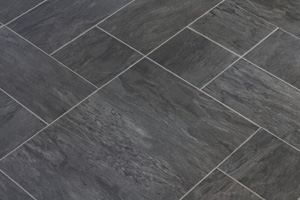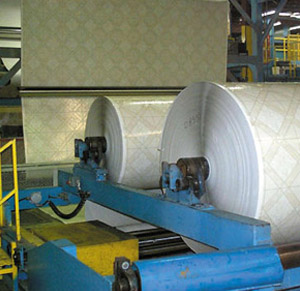Vinyl Construction
The story on how vinyl is made.
While home consists of what’s under your roof, such as family, friends and furnishings, don’t forget what’s under your feet.
Floor coverings also have a huge influence on your home and home life.
In this section we explain how vinyl is made.
This information can be very advantageous because it enables you to understand the product’s materials and evaluate its performance aspects: why certain vinyl floors wear better and longer.
Understanding how vinyl is created can also make you a smarter shopper, help you better determine vinyl value and keep you inside the borders of your budget.
Rotogravure Construction: take your imagination out for a spin.
The manufacturing of vinyl flooring uses highly sophisticated techniques, complex methods and precise systems.
The rotogravure printing process is the most commonly used method for making residential vinyl floors.
It offers you unlimited possibilities in pattern and design.
This process involves a print cylinder that spins around while the vinyl's core layer (called the gel coat) passes underneath.
The cylinder systematically prints various colored ink dyes to create the pattern.
After the print dyes are set a clear wearlayer is applied to the surface.
The appearance retention of a rotogravure vinyl floor is dependent on the durability of the clear wearlayer.
Wearlayer: the “make it or break it” area of vinyl flooring.
The wearlayer is absolutely critical to the performance of your vinyl floor – key to its lasting potential.
The thickness of the wearlayer varies with each vinyl product collection, or series, and is generally measured in mils.
The thickness of a mil is about the same as a page in your telephone book.
So a 10-mil wearlayer would be comparable in thickness to about 10 pages of your phone book.
Generally, the more expensive vinyl floors have thicker wearlayers.
Your expectations for how long your vinyl floor will look new and fresh are based on the wearlayer's performance.
To help you understand wearlayer construction we need to define what the performance characteristics are that we are looking for in a vinyl floor.
These performance characteristics can be divided into these areas:
- Easy to clean
- Stays looking like-new
- Resists staining from normal household products
- Doesn't show scratches easily
- Easy to clean up spills
The easy to clean characteristic relates to how tough it is to remove soiling and other marks from the floor's surface.
When a floor begins to look old and drab it is usually caused by hundreds of fine hairline scratches in the wearlayer.
These fine scratches come from dirt, grit and sand on the wearlayer surface.
However there’s good news. The new generation of vinyl floors has all the ingredients to resist showing wear and staining. Plus all the beauty, style and value to certainly put vinyl in the running as a possible flooring for your home.
Those are the basics of vinyl construction and manufacturing.
We hope this information gives you a better understanding of how this stylish and versatile product is created, and how a well-chosen vinyl floor can help make your home.


